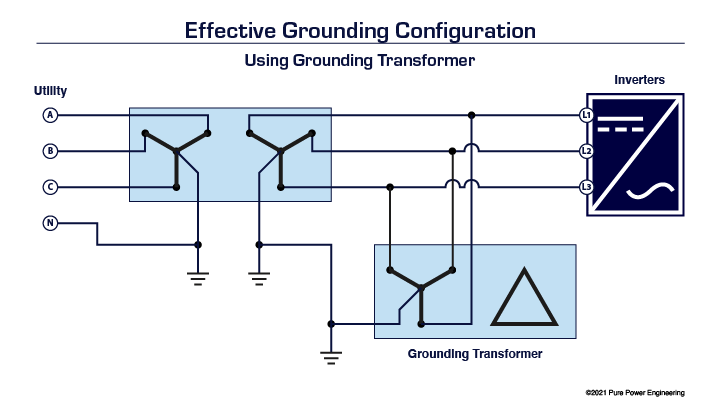Hi, so without getting into the effective grounding discussion in general as it pertains to PV and rolling our eyes, I have a scenario that is a bit different than usual for me and need some thoughts.
This is a customer with substantial load and an existing 3ph, 480v, 4W Yg-Yg 1MVA service and the PV is behind the meter. Normally I am only designing to accommodate the PV direct to grid when the utility requires a grounding bank and would do a zig zag sized relatively small and part of a SEL relay, shunt trip setup, so I can trip well prior to anything that would exceed thermal ratings of transformer. Theoretically the PV is a perfect balanced load so there isn't much neutral current being shunted to ground so a transient over voltage (TOV) shunt to ground would be pretty obvious and with no rotating mass would fizzle out pretty quick when removing source energy to the inverters that have marginal contributory fault current. With customer load in the mix though, that changes that picture with relatively unknown loads ( I would like to avoid doing a load study).
Normally I just design this inline with a delta service with the service ground through the zig zag. I'm not sure how to manage this with customer load and a Y service. Should I isolate the PV with a Y-D transformer then create a new solid ground through the zig zag? Unfortunately I don't thing a new Y-Yg transformer with monitored Ng current would make the EDC happy. Is it plausible to just tap just the phase conductors on the PV feeder and shunt TOV to ground in parallel to the existing 4 wire system - in my head this would only work if I set my trip setting to the appropriate ratio based on service transformer impedance and zig zag impedance (or if I measure both and sum), but does that really isolate the utility from the TOV? The secondary concern which I would agree as well would be islanding but I think that could be managed with appropriate impedance and x/r of the zigzag.
Sorry possibly rambling a little bit and maybe I am overthinking this but its caused a mind block well trying to design this. I'll go get another cup of coffee and see if it clears up or see if someone here has some insight.
Thanks!
Steve
This is a customer with substantial load and an existing 3ph, 480v, 4W Yg-Yg 1MVA service and the PV is behind the meter. Normally I am only designing to accommodate the PV direct to grid when the utility requires a grounding bank and would do a zig zag sized relatively small and part of a SEL relay, shunt trip setup, so I can trip well prior to anything that would exceed thermal ratings of transformer. Theoretically the PV is a perfect balanced load so there isn't much neutral current being shunted to ground so a transient over voltage (TOV) shunt to ground would be pretty obvious and with no rotating mass would fizzle out pretty quick when removing source energy to the inverters that have marginal contributory fault current. With customer load in the mix though, that changes that picture with relatively unknown loads ( I would like to avoid doing a load study).
Normally I just design this inline with a delta service with the service ground through the zig zag. I'm not sure how to manage this with customer load and a Y service. Should I isolate the PV with a Y-D transformer then create a new solid ground through the zig zag? Unfortunately I don't thing a new Y-Yg transformer with monitored Ng current would make the EDC happy. Is it plausible to just tap just the phase conductors on the PV feeder and shunt TOV to ground in parallel to the existing 4 wire system - in my head this would only work if I set my trip setting to the appropriate ratio based on service transformer impedance and zig zag impedance (or if I measure both and sum), but does that really isolate the utility from the TOV? The secondary concern which I would agree as well would be islanding but I think that could be managed with appropriate impedance and x/r of the zigzag.
Sorry possibly rambling a little bit and maybe I am overthinking this but its caused a mind block well trying to design this. I'll go get another cup of coffee and see if it clears up or see if someone here has some insight.
Thanks!
Steve


